Elevation 5 m (16 ft) | Length 35 km (22 mi) Area 3,000 km² | |
Orogeny 357 million years to form Type of rock Types of rock Tonalite, Banded iron formation, Granodiorite Similar South Pass greenstone belt, Abitibi greenstone belt, Seminoe Mountains greenstone belt | ||
Isua greenstone belt | Wikipedia audio article
The Isua Greenstone Belt is an Archean greenstone belt in southwestern Greenland. The belt is aged between 3.7 and 3.8 billion years. The belt contains variably metamorphosed mafic volcanic and sedimentary rocks. The occurrence of boninitic geochemical signatures, characterized by extreme depletion in trace elements that are not fluid mobile, offers evidence that plate tectonic processes in which lithic crust is melted may have been responsible for the creation of the belt. Another theory posits that the belt formed via a process known as vertical plate tectonics.
Contents
- Isua greenstone belt Wikipedia audio article
- Overview
- Scientific methods
- Lithologies
- Tectonics
- Metamorphism
- Results of several studies
- Proposed origin of continental crust
- Formation of the Isua Greenstone Belt
- Controversies
- Vertical plate tectonics
- Similar evidence
- Discovery of early life
- References
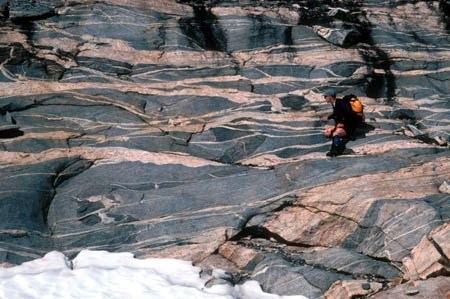
In 2016 melting snow revealed 3.7-billion-year-old stromatolite fossils, the oldest by several hundred million years thus far discovered on Earth. The discovery of complex stromatolite structures at Isua, formed from accreted biofilm layers so early in the history of the Earth suggests that life first evolved on Earth over 4 billion years ago.
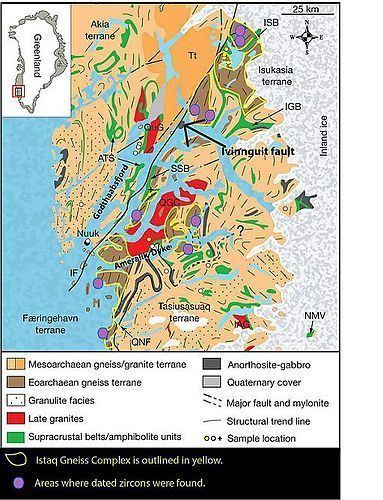
Overview
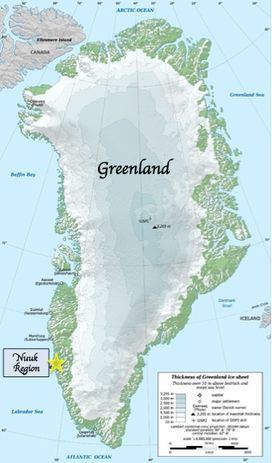
The Isua greenstone belt, also known as the Isua supracrustal belt since it is composed of supracrustal rock deposited upon basement rock strata, is located in the southwestern portion of Greenland, in the Isukasia terrane, near the Nuuk capital region. The greenstone belt is made up of metamorphosed mafic volcanic and sedimentary rocks that are usually juxtaposed by mylonites or fault boundaries. By using uranium-lead dating on zircon and titanite, the tectonic history was dated to be approximately 3,700–3,600 million years old. The Isua Greenstone has been studied by Earth scientists due to evidence the area holds for early Earth plate tectonics, since it houses one of the oldest, best-preserved ancient plate tectonic sequences. In addition, the area is large, exposed, and there are areas that have experienced relatively low deformation and alteration to the original rock sequences. The Isua Greenstone is divided into a northern and a southern section by the Ivinnguit Fault, shown on the map below right. The northern area of the Isua Greenstone Belt is mainly composed of amphibolite rocks, volcanic rocks, upper mantle peridotite, and layered gabbros; a suite which suggests crustal shortening.
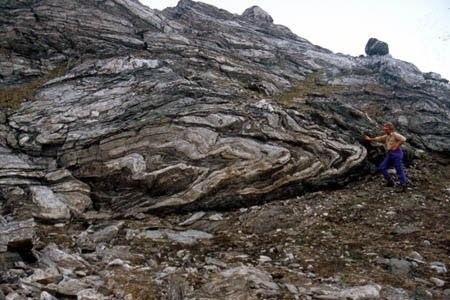
Scientists have used different methods to determine how the Isua Greenstone Belt formed. Some conclude that it formed at an ancient ocean-ocean convergent zone, where subduction-caused partial melting and metasomatism of the mantle as well as the intrusion of tonalites partially melted the overlying supracrustal rocks and created the first continental crust. However, the geological evolution of the Isua Greenstone Belt remains controversial, as scientists try to come to a consensus on how it formed: whether due to such a subduction zone or to some other former process like vertical plate tectonics. Ultimately, a specific conclusion of how the Isua Greenstone Belt formed has not been reached, but some pieces of the puzzle have been proposed.
Scientific methods

In an attempt to understand the origin of the Isua Greenstone Belt, scientists have used several different methods. These include enlisting U-Pb zircon dating that measures the decay of uranium to lead in zircons using sensitive high-resolution ion microprobe (SHRIMP), analysing elemental chemistry and composition, rendering three-dimensional features on paper using the stereographic projections that geologists call "stereonets", and assessing lithologic associations. In addition to information gathered directly from the rocks, scientists have also used observations of the placement of the rocks and how they are separated into units: this is a more kinematic approach to the area. In addition, zoned garnets from different areas of the Isua Greenstone Belt have been used in garnet-biotite geothermometry, which has been used to determine the timing of metamorphism. Scientists have tried to relate their findings to modern day proxies of subduction zones and other tectonic events.
Lithologies
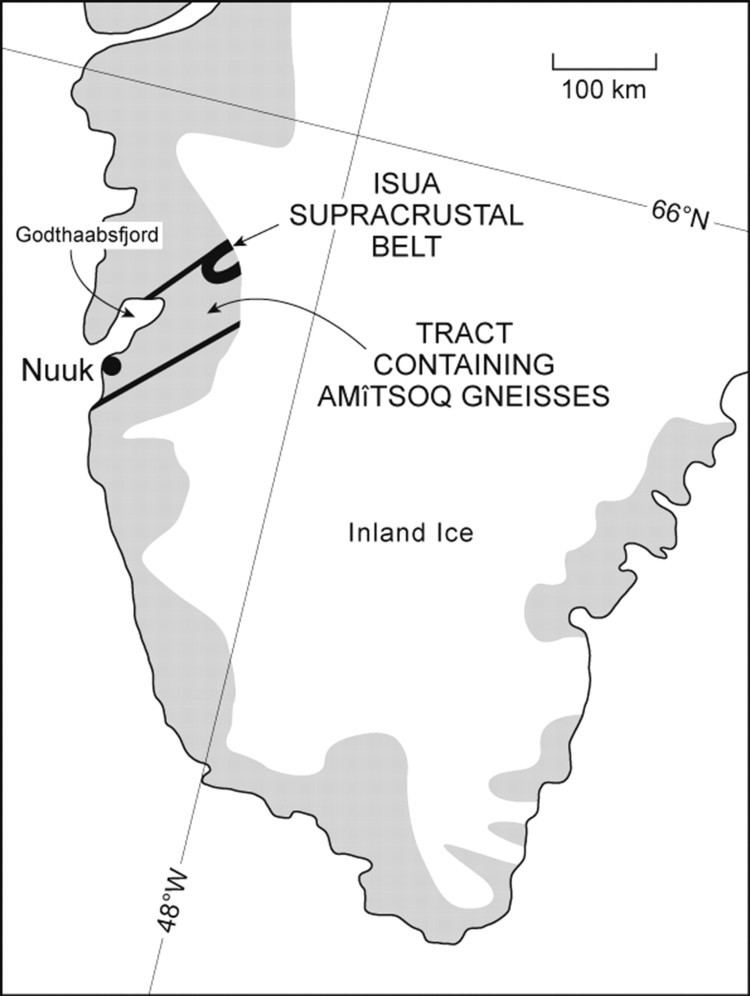
Efforts to depict initial lithologies and tectonic formations of the Isua Greenstone Belt have been difficult due to the immense episodes of regional metamorphism the area has experienced, which is why most efforts have been focused on the northern complex, called the Isukasia Terrane, where the rocks have experienced a lower metamorphic grade. There are several lithologies that make up the Isua Greenstone Belt and the main rock types have been located and mapped. These include the Amitsoq Tonalite-Trondhjemite-Granodiorite (TTG) orthogneisses, Pillow lavas and pillow breccias, banded iron formations, granodiorites, and metasedimentary rocks. In addition, the area contains other, less prevalent, lithologies such as meta-chert, and mafic volcanic rocks. Although there is still some debate on the kinematics of how each rock type was formed, the map at right shows a part of the Isua Supracrustal belt; these rock types are clues to the formation of the greenstone belt and have been extensively mapped. The map illustrates the entire greenstone belt area, with rock types and locations, found on the southwestern portion of Greenland. Below the map is a general timeline that shows when each rock was intruded into the greenstone belt.
1) Tonalitic Amitsoq orthogneisses:

2) Pillow lavas and pillow breccias:

3) Banded Iron Formations:
4) Peridotites:
Tectonics
The Isua Greenstone Belt offers up some complications because of the tectonics that have occurred in the area. Subduction and plate tectonics overall, is a means for explaining heat transfer within the Earth, which was an important process in early Earth. The Isua Greenstone Belt is also an important area on the globe because it in particular contains the only evidence on the Earth that holds record for deformation before 3.2 billion years ago.
Some scientists have observed geometric patterns in the area and have attributed it to a certain type of tectonic event called a thrust nappe. The klippe is the isolated block of the nappe overlying autochthonous material. This geologic formation is evidence of thrusting plate motion, towards the south in this particular region. A thrust suggests that this area did experience subduction in the Archean. The implications of this come from studies of the deformational behavior, rheology, and strength of the Archean crust, all of which has been proposed to be very similar to the current crust.
Metamorphism
Evidence from zoned garnets can give insight into the metamorphic history of an area. What one scientist found was that there were three main episodes of garnet growth in the Isua Greenstone Belt, meaning there were three main metamorphic events. Specifically, the garnets were studied in terms of overgrowth patterns using iron-magnesium rich rim, manganese rich cores, then by a calcium-rich rims and cores. In addition, the presence of these overgrowths and their oscillatory zoned nature leads scientists to believe that the metamorphism occurred due to fluid-like metasomatism. Manganese is suggestive of prograde metamorphism. Overall it has been suggested that there were three metamorphic events, occurring 3.74 billion years ago, 3.69 billion years ago, and at 2.8 billion years ago.
Results of several studies
The following table shows, in a condensed form, the efforts of many scientists and the evidence that they found, as well as their idea of what it could mean for the formation of early Archean continental crust.
Much of this evidence has been used to describe modern day plate tectonics. A problem with this is that Archean plate tectonics could have been vastly different than the processes that are occurring on Earth today.
Proposed origin of continental crust
The easiest way to think about the Isua Greenstone Belt is in two parts: a north and a south which are broken up by a fault. The northern terrane is dominated by tonalites and is the least metamorphosed section. It also contains zircon ages of approximately 3710-3690 million years old. The southern portion of the Isua Greenstone Belt contains approximately 3900-3810 million year old zircons with an abundance of amphibolite, schist, carbonate rock, volcanics, pillow lavas, and ultramafics. The northern portion makes up the area where many scientific studies have been conducted and offers up the evidence leading scientists to propose the following hypothesis.
Formation of the Isua Greenstone Belt
A reconstruction of the origin of continental crust, which formed the greenstone belt, using geochemical, lithological, and structural clues, is predicated upon two assumptions: first, new Hadean crust formed laterally by the expelling and lateral accretion of mafic to ultramafic lavas. Then stabilization occurred through the re-melting of the crust.
The reworked crust can be attributed to the burial, most likely through subduction, of hydrated materials, such as basalt, that were formed in the Hadean. Additionally, the source for tested rock samples came from a mantle depleted in titanium and niobium and enriched in lead, strontium, barium, rubidium, and light rare earth elements, which, taken together, are indicative of arc-related basalts. The diorites found in the area are high in magnesium and REE (rare earth elements), which suggest further that the rocks were formed from a mixture of the mantle and remelted basaltic crust. Overall, the presence of tonalite-trondhjemite-granodiorites, as well as the iron present for the banded iron formations (BIFs), are determined to have been caused by hydrothermal alteration at high temperatures. BIFs are typically found in intra-oceanic, arc or forearc settings, which are associated with convergent boundaries. The intrusions were formed when upwelling asthenosphere partially melted thick overlying oceanic crust. It is thought that the melting and reworking of oceanic crust formed the early Archean continental crust. In addition, the eclogite residues, formed by the partial melting of the oceanic crust, subsequently became a part of the sub-continental lithospheric mantle. By using uranium-lead dating on zircons, scientists were able to determine that the process of creating the Isua Greenstone Belt took approximately 300 million years.
Many pieces of evidence are brought together to support the theory that the formation of continental crust must have started with the subduction of hot oceanic crust. This subducting slab melted, and the rising magma gravitationally differentiated into a more granitic composition, characteristic of continental crust. The result of testing and putting together information has led scientists to believe that crustal growth began approximately 3.8 billion years ago. and continued building slowly, in a sequence of comparatively brief episodes. Then crust quickly stabilized about 2.975 billion years ago. The schematic image above right shows two possible flat subduction mechanisms that could create the tonalite plutons seen in the greenstone belt. However, this theory of crustal formation has been questioned by many scientists.
Controversies
In the scientific community, studies are still being conducted that hope to solve the big question of the Isua Greenstone Belt: What processes caused its formation? This area remains under controversy in the scientific community because it is arguable that there were different tectonic processes, or styles, occurring in Archean times that would have affected the outcome of what we see today: a mass of very old rocks surrounded by younger rocks that have been heavily altered in some areas and are separated by tectonic and depositional contacts. The Isua Greenstone Belt is the only place in the world that does not conform entirely to the idea of vertical plate tectonics (an idea that is still debated).
Some of the problems are:
- There are few zircons available for dating.
- Deformation in the area has destroyed important information.
- The isotopic chemistry is known, but is only attributed to current day proxies, which may have been different in the Archean.
- There is very little preserved mafic crust from the Archean.
Vertical plate tectonics
There is an alternate idea that early Earth plate tectonics began by vertical movement of the lithosphere, rather than the modern horizontal tectonics. This theory rejects the idea of subduction and arc accretion in the formation of greenstone belts. It suggests that convective overturn due to density differences between the overlying mafic sequence (greenstone) and partially molten granitic middle crust is responsible for the observed formations.
Similar evidence
The Isua Greenstone Belt is an anomaly in terms of the other greenstone belts in the world. It is the only greenstone belt that has preserved deformational events from greater than 3.2 Ga and contains peridotites (indicating an obducted ophiolite sequence). However, as compared to the Pilbara Craton and the Barberton Greenstone Belts, which have alternate evolution theories, there are a few similarities.
Discovery of early life
Because of its age, the Isua Greenbelt has long been the focus of studies seeking to identify signs of early terrestrial life. In 1996, geologist Steve Mojzsis and colleagues hypothesized that isotopically light carbon in the structure’s carbon-rich layers was suggestive of biological activity having occurred there. “Unless some unknown abiotic process exists which is able both to create such isotopically light carbon and then selectively incorporate it into apatite grains, our results provide evidence for the emergence of life on Earth by at least 3,800 Myr before present.”
In August 2016, an Australia-based research team presented evidence that the Isua Greenstone Belt contains the remains of stromatolite microbial colonies that formed approximately 3.7 billion years ago. These remains predate the oldest previously known stromatolite remains, found in the Dresser Formation in western Australia, by 220 million years.
The complexity of the stromatolites found at Isua suggest that life on Earth was already sophisticated and robust by the time of their formation, and that the earliest life on Earth likely evolved over 4 billion years ago. This conclusion is supported in part by the instability of Earth's surface conditions 3.7 billion years ago, which included intense asteroid bombardment. The formation and preservation of fossils from this period indicate that life evolved early and prolifically in Earth's history.
The stromatolite fossils appear wavy and dome-shaped, are typically 1–4 cm (0.4–1.6 in) high, and were found in iron- and magnesium-rich dolomite sedimentary rocks that had recently been exposed by melting snow. The surrounding rocks suggest that the stromatolites lived and were deposited in a shallow marine environment. While most rocks in the Isua Greenstone Belt are too metamorphically altered to preserve fossils, the area of stromatolite discovery has preserved original sedimentary rocks, and the fossils inside them.
The ISB sedimentary layers containing the stromatolites overlay volcanic rocks that are dated to 3.709 billion years old, and are capped by dolomite sediments and banded iron formations with thorium-uranium zircons dated to 3.695 ± 0.4 billion years old. All layers, including those bordering the stromatolites, experienced metamorphism and deformation after deposition, and temperatures not exceeding 550 °C (1,000 °F).
The identity of the ISB features as stromatolites is controversial, because similar features may form through non-biological processes. However, apparent sand accumulation against the sides of the putative stromatolites during their formation suggest that observed, dome-like features arose during the sedimentary process, and not through later, metamorphic deformation. This suggests the features are fossils of ancient stromatolites.
areologist Abigail Allwood stated that the discovery of Isua stromatolites makes the emergence of life on other planets, including Mars early after its formation, more probable.
The ISB stromatolites remain a subject of ongoing investigation.
